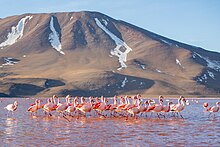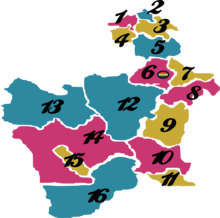Potosí (Spanish pronunciation: [potoˈsi]; Quechua: P'utuqsi; Aymara: Putusi) is a department in southwestern Bolivia. It comprises 118,218 km2 with 823,517 inhabitants (2012 census). The capital is the city of Potosí. It is mostly a barren, mountainous region with one large plateau to the west, where the largest salt flat in the world, Salar de Uyuni, is located.
Potosí | |
|---|---|
 Cerro Lipez, a stratovolcano | |
 Location within Bolivia | |
| Coordinates: 20°40′0″S 66°40′0″W / 20.66667°S 66.66667°W | |
| Country | |
| Capital | Potosí |
| Government | |
| • Body | Departmental Legislative Assembly of Potosí |
| • Governor | Jhonny Mamani (MAS-IPSP) |
| Area | |
| • Total | 118,218 km2 (45,644 sq mi) |
| Population (2020) | |
| • Total | 901,600 |
| • Density | 7.6/km2 (20/sq mi) |
| Time zone | UTC-4 (BOT) |
| HDI (2019) | 0.631[1] medium · 9th of 9 |
| GDP (2023) | in constant values of 2015[2] |
| - Total | US$ 1.8 billion Int$ 4.2 billion (PPP) |
| - Per capita | US$ 1,900 Int$ 4,400 (PPP) |
Cerro Potosí was the richest province in the Spanish empire, providing a great percentage of the silver that was shipped to Europe.
Potosi is also the location of the San Cristóbal silver, zinc and lead mines, developed by the US-company Apex Silver Mines Limited of Colorado and in November 2008 sold to the Japanese Sumitomo Corporation.

History
In March 2023, social organisations in four regions of Potosí, with the support of regional MAS-IPSP lawmakers, called for a strike spanning over 72 hours, to force the government to raise infrastructure investments in the department and to receive an increased amount of the profits generated through lithium mining in the region.[3] Shortly after the strike an agreement with the central government could be reached, stipulating the construction of motorways and a cement plant and further discussions about mining conditions.[3]
Government
Executive offices
The chief executive office of Bolivia departments (since May 2010) is the governor; until then, the office was called the prefect, and until 2006 the prefect was appointed by the President of Bolivia. The current governor, Jhonny Mamani of the Movement for Socialism – Political Instrument for the Sovereignty of the Peoples was elected on 7 March 2021.[4]
| Took office | Office expired | Prefect/Governor | Party | Notes |
|---|---|---|---|---|
| 23 Jan 2006 | 30 May 2010 | Mario Virreira Iporre | MAS-IPSP | First elected prefect. Elected in Bolivian general election, December 2005 |
| 30 May 2010 | 31 May 2015 | Félix Gonzáles | MAS-IPSP | Elected in regional election on 4 April 2010 with 63.1% of the vote; first governor. |
| 31 May 2015 | 15 Nov 2019 | Juan Carlos Cejas | MAS-IPSP | Elected in regional election on 29 March 2015. |
| 15 Nov 2019 | 3 May 2021 | Omar Veliz Ramos | MAS-IPSP | |
| 3 May 2021 | Jhonny Mamani | MAS-IPSP | Elected in regional election on 7 March 2021.[4] |
Legislative Assembly
Under the 2009 Constitution, each Bolivian department has an elected Departmental Legislative Assembly. The first elections were held 4 April 2010.
The current executive committee consists of Jacinto Sunagua Dorado as president, Raimunda Cordero Caba as vice-president and Alberto Quispe Mamani as secretary and Blanca Celia Burgos Quispe and Leon Jancko Condori as first and second committee member, respectively.[5]
Demographics
| Year | Pop. | ±% p.a. |
|---|---|---|
| 1976 | 657,743 | — |
| 1992 | 645,889 | −0.11% |
| 2001 | 709,013 | +1.04% |
| 2012 | 828,093 | +1.42% |
| 2020 | 901,600 | +1.07% |
| Source: Citypopulation[6] | ||
Provinces of Potosi Department
The department is divided into 16 provinces which are further subdivided into 40 municipalities[7] (municipios) and 219 cantons (cantones).
| Province | Capital | Area km2 | Population (2012 census) | Map Number |  |
|---|---|---|---|---|---|
| Alonso de Ibáñez | Sacaca | 2.170 | 29.821 | 1 | |
| Antonio Quijarro | Uyuni | 14,890 | 54,947 | 12 | |
| Bernardino Bilbao | Arampampa | 640 | 10,224 | 2 | |
| Charcas | San Pedro de Buena Vista | 2,964 | 41,214 | 3 | |
| Chayanta | Colquechaca | 7,026 | 97,251 | 5 | |
| Cornelio Saavedra | Betanzos | 2,375 | 55,100 | 7 | |
| Daniel Campos | Llica | 12,106 | 5,850 | 13 | |
| Enrique Baldivieso | San Agustín | 2,254 | 1,684 | 15 | |
| José María Linares | Puna | 5,136 | 49,619 | 8 | |
| Modesto Omiste | Villazón | 2,260 | 44,645 | 11 | |
| Nor Chichas | Cotagaita | 8,979 | 42,248 | 9 | |
| Nor Lípez | Colcha K | 20,892 | 14,057 | 14 | |
| Rafael Bustillo | Uncía | 2,235 | 86,947 | 4 | |
| Sud Chichas | Tupiza | 8,516 | 55,879 | 10 | |
| Sud Lípez | San Pablo de Lípez | 22,355 | 6,835 | 16 | |
| Tomás Frías | Potosí | 3,420 | 229,047 | 6 |
Economy
Mining
- Pando mine (Gold)
- Salar de Uyuni mine (Lithium)
- San Vicente mine (Silver)
Languages
| Language | Department | Bolivia |
|---|---|---|
| Quechua | 514,421 | 2,281,198 |
| Aymara | 57,738 | 1,525,321 |
| Guaraní | 374 | 62,575 |
| Another native | 356 | 49,432 |
| Spanish | 438,204 | 6,821,626 |
| Foreign | 3,771 | 250,754 |
| Only native | 226,967 | 960,491 |
| Native and Spanish | 301,280 | 2,739,407 |
| Spanish and foreign | 136,980 | 4,115,751 |
The languages spoken in the department are mainly Quechua, Spanish and Aymara. The following table shows the number of those belonging to the recognized group of speakers.[8]
Places of interest
Notable people
- Juana Azurduy de Padilla, guerrilla military leader.
- Manuel Ascencio Padilla, namesake of the town of Padilla, Bolivia.
- Modesto Omiste Tinajeros, writer, politician, and namesake of the province Modesto Omiste.
See also
References
External links


